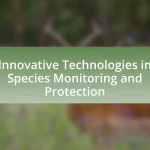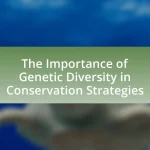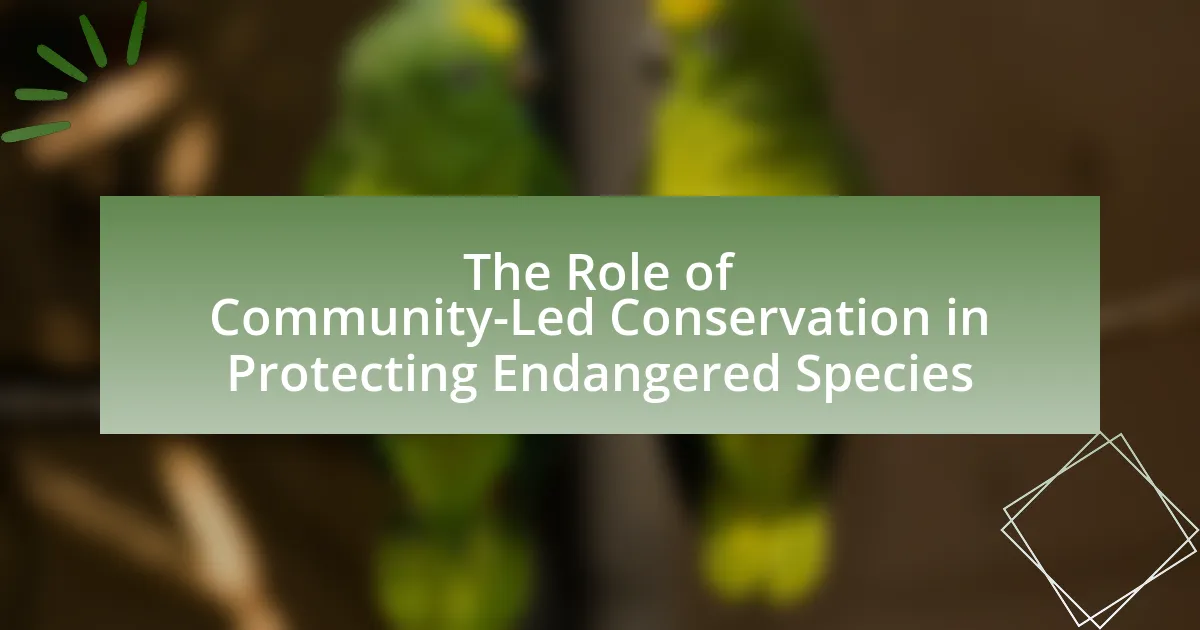Zoos and aquariums play a vital role in species conservation by engaging in breeding programs, habitat restoration, and public education initiatives. They participate in collaborative efforts such as Species Survival Plans to manage and conserve endangered species, successfully reintroducing over 200 species into their natural habitats. These institutions also face challenges, including funding limitations and ethical considerations regarding animal welfare, while actively working to enhance public awareness of conservation issues. Through partnerships with conservation organizations and innovative practices, zoos and aquariums strive to improve their impact on biodiversity and ecosystem health.
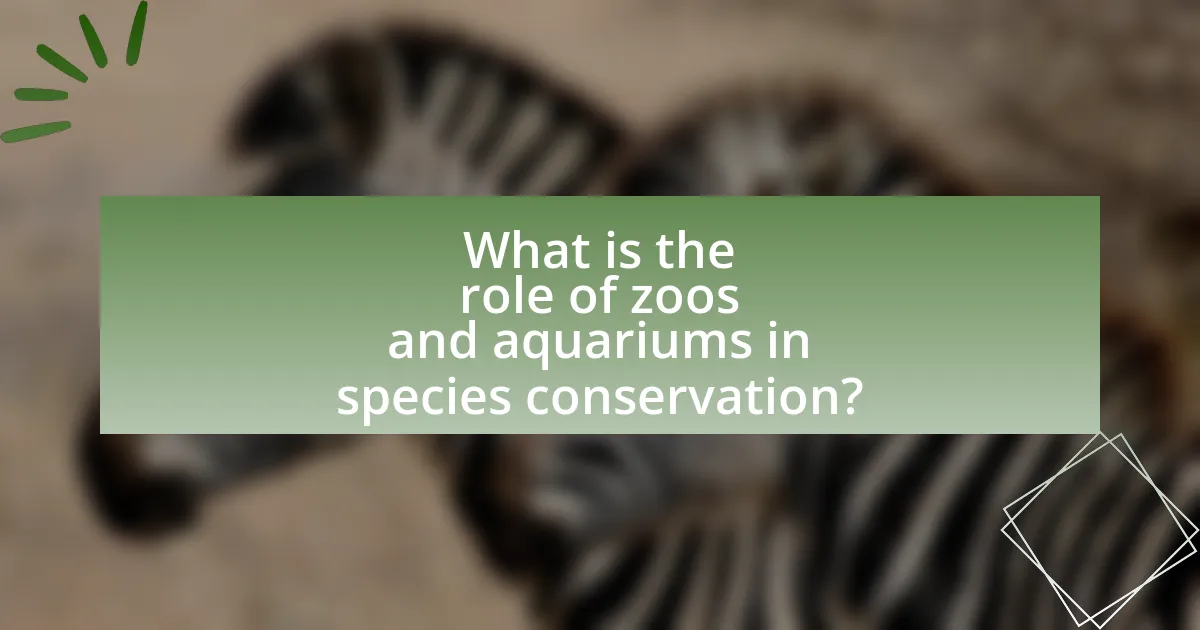
What is the role of zoos and aquariums in species conservation?
Zoos and aquariums play a crucial role in species conservation by providing a controlled environment for breeding endangered species, conducting research, and educating the public about biodiversity. These institutions often participate in Species Survival Plans, which are collaborative efforts to manage and conserve threatened species through captive breeding and reintroduction programs. For example, the Association of Zoos and Aquariums reported that over 200 species have been successfully bred in captivity and reintroduced into their natural habitats, significantly contributing to the recovery of species like the California condor and the Arabian oryx. Additionally, zoos and aquariums engage in habitat preservation initiatives and support field conservation projects, further enhancing their impact on global biodiversity conservation.
How do zoos and aquariums contribute to the preservation of endangered species?
Zoos and aquariums contribute to the preservation of endangered species through breeding programs, habitat conservation, and public education initiatives. These institutions often participate in Species Survival Plans, which are coordinated efforts to breed endangered species in captivity and reintroduce them into their natural habitats. For example, the California condor was brought back from the brink of extinction through a captive breeding program initiated by zoos. Additionally, zoos and aquariums engage in habitat restoration projects, protecting ecosystems that are vital for the survival of various species. They also educate the public about conservation issues, fostering awareness and support for endangered species. This multifaceted approach is essential for the long-term survival of many species facing threats from habitat loss, poaching, and climate change.
What specific conservation programs are implemented by zoos and aquariums?
Zoos and aquariums implement various specific conservation programs, including breeding programs, habitat restoration initiatives, and wildlife rehabilitation efforts. Breeding programs, such as the Species Survival Plan (SSP), aim to maintain genetic diversity and support endangered species populations. Habitat restoration initiatives focus on restoring ecosystems to support wildlife, often in collaboration with local communities and conservation organizations. Wildlife rehabilitation efforts involve rescuing and rehabilitating injured or orphaned animals, with the goal of releasing them back into their natural habitats. These programs are supported by research and funding from organizations like the Association of Zoos and Aquariums (AZA), which emphasizes the importance of conservation in their accreditation standards.
How do breeding programs in zoos and aquariums support species conservation?
Breeding programs in zoos and aquariums support species conservation by increasing population numbers of endangered species and facilitating genetic diversity. These programs often involve carefully managed breeding to ensure that genetic variability is maintained, which is crucial for the long-term survival of species. For example, the Association of Zoos and Aquariums (AZA) manages Species Survival Plans (SSPs) that coordinate breeding efforts across institutions to maximize genetic diversity and minimize inbreeding. Additionally, successful breeding programs have led to the reintroduction of species into their natural habitats, such as the California condor and the Arabian oryx, demonstrating their effectiveness in conservation efforts.
Why are zoos and aquariums considered important for biodiversity?
Zoos and aquariums are considered important for biodiversity because they play a crucial role in the conservation of endangered species and the preservation of genetic diversity. These institutions engage in breeding programs that help to increase population numbers of threatened species, such as the California condor and the black-footed ferret, which were on the brink of extinction. Additionally, zoos and aquariums contribute to biodiversity by conducting research that informs conservation strategies and by educating the public about the importance of protecting wildlife and their habitats. This multifaceted approach not only aids in the survival of individual species but also supports broader ecosystem health and resilience.
What impact do zoos and aquariums have on public awareness of conservation issues?
Zoos and aquariums significantly enhance public awareness of conservation issues by providing educational programs and direct engagement with wildlife. These institutions often host workshops, guided tours, and interactive exhibits that inform visitors about endangered species and the threats they face, such as habitat loss and climate change. For instance, a study published in the Journal of Zoo and Aquarium Research found that visitors to zoos reported increased knowledge about conservation after their visit, with 70% indicating a greater understanding of the importance of protecting biodiversity. This educational impact fosters a sense of responsibility and encourages individuals to participate in conservation efforts, thereby amplifying the overall awareness of environmental issues.
How do zoos and aquariums collaborate with other conservation organizations?
Zoos and aquariums collaborate with other conservation organizations through joint research initiatives, species recovery programs, and habitat restoration projects. These collaborations often involve sharing expertise, resources, and data to enhance conservation efforts. For instance, the Association of Zoos and Aquariums (AZA) partners with organizations like the World Wildlife Fund (WWF) to implement conservation strategies that protect endangered species. Additionally, many zoos and aquariums participate in global breeding programs, such as the European Endangered Species Programme, which aims to maintain genetic diversity and support reintroduction efforts in the wild. This collaborative approach is essential for addressing complex conservation challenges effectively.

What challenges do zoos and aquariums face in species conservation?
Zoos and aquariums face significant challenges in species conservation, primarily due to limited funding and resources. Financial constraints often restrict their ability to conduct extensive research, maintain adequate facilities, and implement effective breeding programs. For instance, a study by the Association of Zoos and Aquariums indicates that many institutions operate on tight budgets, which can hinder their conservation efforts. Additionally, the challenges of habitat loss and climate change further complicate conservation initiatives, as these factors impact the species that zoos and aquariums aim to protect. Furthermore, public perception and ethical considerations regarding animal captivity can affect support for conservation programs, making it difficult for these institutions to garner the necessary public and governmental backing.
How do ethical considerations influence the operations of zoos and aquariums?
Ethical considerations significantly influence the operations of zoos and aquariums by guiding their practices towards animal welfare, conservation, and education. These institutions are increasingly adopting ethical frameworks that prioritize the well-being of animals, ensuring that enclosures mimic natural habitats and that animals are not subjected to unnecessary stress or harm. For instance, the World Association of Zoos and Aquariums emphasizes the importance of ethical standards in animal care, which has led to improved living conditions and enrichment programs that promote natural behaviors. Furthermore, ethical considerations drive zoos and aquariums to engage in conservation efforts, such as breeding programs for endangered species, which are essential for maintaining biodiversity. Research indicates that zoos contribute to species conservation, with a study published in the journal “Conservation Biology” highlighting that over 200 species have been saved from extinction through captive breeding and reintroduction programs. Thus, ethical considerations are integral to the operational frameworks of zoos and aquariums, shaping their commitment to animal welfare and conservation initiatives.
What are the arguments for and against keeping animals in captivity?
Arguments for keeping animals in captivity include conservation efforts, education, and research opportunities. Captive breeding programs in zoos and aquariums have successfully reintroduced endangered species into the wild, such as the California condor, which saw its population rise from 27 individuals in 1987 to over 500 today due to these initiatives. Additionally, zoos provide educational experiences that raise awareness about wildlife conservation, fostering public support for environmental protection.
Arguments against keeping animals in captivity focus on ethical concerns, animal welfare, and the limitations of artificial environments. Critics argue that captivity can lead to physical and psychological issues in animals, such as stereotypic behaviors and reduced life expectancy. For instance, studies have shown that elephants in captivity often exhibit signs of stress and depression, which raises questions about the morality of keeping them confined. Furthermore, some argue that captivity does not adequately prepare animals for survival in the wild, as they may lose essential survival skills.
How do zoos and aquariums address concerns about animal welfare?
Zoos and aquariums address concerns about animal welfare through comprehensive care programs that prioritize the physical and psychological well-being of animals. These institutions implement enrichment activities, which are designed to stimulate natural behaviors and reduce stress, thereby enhancing the quality of life for the animals. For instance, the Association of Zoos and Aquariums (AZA) sets rigorous standards for animal care, including habitat design, nutrition, and veterinary care, ensuring that animals live in environments that closely mimic their natural habitats. Additionally, many zoos and aquariums engage in research and conservation efforts that focus on species preservation, which further supports animal welfare by promoting genetic diversity and healthy populations.
What financial and logistical challenges do zoos and aquariums encounter?
Zoos and aquariums face significant financial and logistical challenges that impact their operations and conservation efforts. Financially, they often rely on ticket sales, donations, and grants, which can fluctuate due to economic downturns or changes in public interest, leading to budget constraints that affect animal care and habitat maintenance. Logistically, these institutions must manage complex animal husbandry, including sourcing food, ensuring proper veterinary care, and maintaining suitable living environments, all of which require substantial resources and expertise. For instance, the Association of Zoos and Aquariums reported that many facilities struggle with rising operational costs, which can exceed their revenue, thereby hindering their ability to invest in conservation programs and educational initiatives.
How do funding sources affect conservation efforts in zoos and aquariums?
Funding sources significantly influence conservation efforts in zoos and aquariums by determining the financial resources available for programs and initiatives. For instance, zoos and aquariums that receive government funding often have more stable budgets, allowing for long-term conservation projects, while those reliant on private donations may face fluctuations that hinder consistent efforts. According to a study published in the Journal of Zoo and Aquarium Research, institutions with diversified funding sources, including grants, memberships, and corporate sponsorships, are better positioned to implement effective conservation strategies and support research initiatives. This financial stability enables them to engage in breeding programs, habitat restoration, and public education, which are critical for species conservation.
What role does visitor attendance play in the sustainability of conservation programs?
Visitor attendance is crucial for the sustainability of conservation programs as it directly influences funding and resource allocation. Increased visitor numbers lead to higher ticket sales and donations, which are essential for maintaining and expanding conservation efforts. For instance, a study by the Association of Zoos and Aquariums found that zoos and aquariums contribute over $200 million annually to global conservation initiatives, largely funded by visitor revenue. This financial support enables programs to conduct research, habitat restoration, and species recovery efforts, thereby enhancing their effectiveness and longevity.
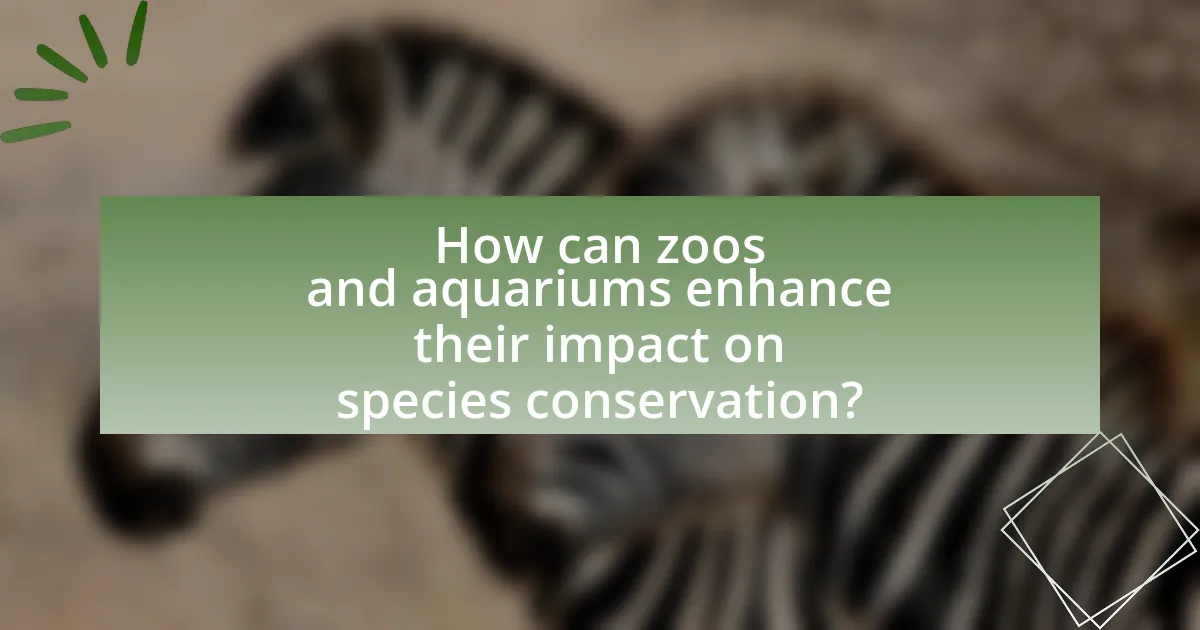
How can zoos and aquariums enhance their impact on species conservation?
Zoos and aquariums can enhance their impact on species conservation by implementing comprehensive breeding programs, habitat restoration initiatives, and educational outreach efforts. Breeding programs, such as those for the California condor and the black-footed ferret, have successfully increased population numbers and genetic diversity, demonstrating their effectiveness in species recovery. Habitat restoration initiatives, like the reintroduction of species into their native environments, further support conservation goals, as seen with the successful reintroduction of the Arabian oryx in Oman. Additionally, educational outreach programs raise public awareness about conservation issues, fostering community support and involvement, which is crucial for long-term conservation success. These combined efforts not only contribute to the survival of endangered species but also promote biodiversity and ecosystem health.
What innovative practices can zoos and aquariums adopt for better conservation outcomes?
Zoos and aquariums can adopt innovative practices such as implementing advanced breeding programs, utilizing genetic management, and engaging in habitat restoration projects to achieve better conservation outcomes. Advanced breeding programs, like those seen in the Association of Zoos and Aquariums’ Species Survival Plans, focus on maintaining genetic diversity and increasing population numbers of endangered species. Genetic management ensures that breeding pairs are selected based on genetic compatibility, which enhances the overall health of the population. Additionally, zoos and aquariums can participate in habitat restoration projects, which directly contribute to the recovery of species in their natural environments, as demonstrated by the successful reintroduction of species like the California condor. These practices not only support species conservation but also foster public awareness and education about biodiversity and ecosystem health.
How can technology be utilized to improve conservation efforts in zoos and aquariums?
Technology can be utilized to improve conservation efforts in zoos and aquariums through advanced data analytics, habitat simulation, and genetic research. Advanced data analytics enables institutions to monitor animal health and behavior in real-time, facilitating timely interventions that enhance species survival rates. Habitat simulation technologies, such as virtual reality and augmented reality, allow for the recreation of natural environments, which can improve animal welfare and breeding success. Genetic research, supported by technologies like CRISPR, aids in understanding genetic diversity and developing breeding programs that maintain healthy populations. For instance, the San Diego Zoo has successfully used genetic tools to increase the genetic diversity of endangered species, demonstrating the effectiveness of technology in conservation efforts.
What role does education play in enhancing conservation efforts at zoos and aquariums?
Education plays a crucial role in enhancing conservation efforts at zoos and aquariums by raising public awareness and fostering a connection between visitors and wildlife. Through educational programs, exhibits, and interactive experiences, these institutions inform the public about biodiversity, the importance of conservation, and the threats faced by various species. For instance, studies have shown that visitors who engage in educational activities at zoos are more likely to support conservation initiatives, with a survey indicating that 70% of zoo visitors felt inspired to take action for wildlife conservation after their visit. This increased awareness can lead to greater public support for conservation policies and funding, ultimately contributing to the preservation of endangered species and their habitats.
What are some best practices for zoos and aquariums in species conservation?
Best practices for zoos and aquariums in species conservation include implementing breeding programs, conducting research, and engaging in habitat restoration. Breeding programs, such as the Species Survival Plan, help maintain genetic diversity and support reintroduction efforts for endangered species. Research initiatives contribute to understanding species’ needs and behaviors, which can inform conservation strategies. Habitat restoration projects, often in collaboration with conservation organizations, aim to rehabilitate ecosystems that support native wildlife. These practices are supported by data indicating that zoos and aquariums play a critical role in the conservation of over 700 species globally, demonstrating their effectiveness in preserving biodiversity.
How can zoos and aquariums effectively engage the public in conservation initiatives?
Zoos and aquariums can effectively engage the public in conservation initiatives by implementing interactive educational programs and hands-on experiences that foster a connection between visitors and wildlife. For instance, programs such as behind-the-scenes tours, animal encounters, and conservation workshops allow visitors to learn about endangered species and the importance of biodiversity. Research indicates that such immersive experiences significantly increase public awareness and support for conservation efforts, as evidenced by a study published in the Journal of Zoo and Aquarium Research, which found that participants in these programs showed a 40% increase in conservation knowledge and a greater likelihood of participating in conservation activities post-visit.
What partnerships can zoos and aquariums form to strengthen conservation efforts?
Zoos and aquariums can form partnerships with non-governmental organizations (NGOs), academic institutions, and governmental agencies to strengthen conservation efforts. Collaborating with NGOs allows zoos and aquariums to leverage expertise in field conservation and community engagement, enhancing on-the-ground impact. Partnerships with academic institutions facilitate research and education initiatives, providing valuable data for species recovery programs. Additionally, working with governmental agencies ensures alignment with national conservation policies and access to funding opportunities, which can amplify conservation projects. For instance, the Association of Zoos and Aquariums (AZA) collaborates with various organizations to implement the Species Survival Plan, demonstrating the effectiveness of such partnerships in achieving conservation goals.
What practical steps can individuals take to support zoos and aquariums in their conservation efforts?
Individuals can support zoos and aquariums in their conservation efforts by visiting these institutions, as ticket sales directly fund their programs. Engaging in membership or donation programs also provides essential financial resources for conservation initiatives. Additionally, volunteering time and skills can enhance operational capabilities and outreach efforts. Educating oneself and others about the importance of conservation and advocating for wildlife protection can further amplify the impact of these institutions. According to the Association of Zoos and Aquariums, zoos contribute over $200 million annually to global conservation efforts, demonstrating the significant role that public support plays in these initiatives.

